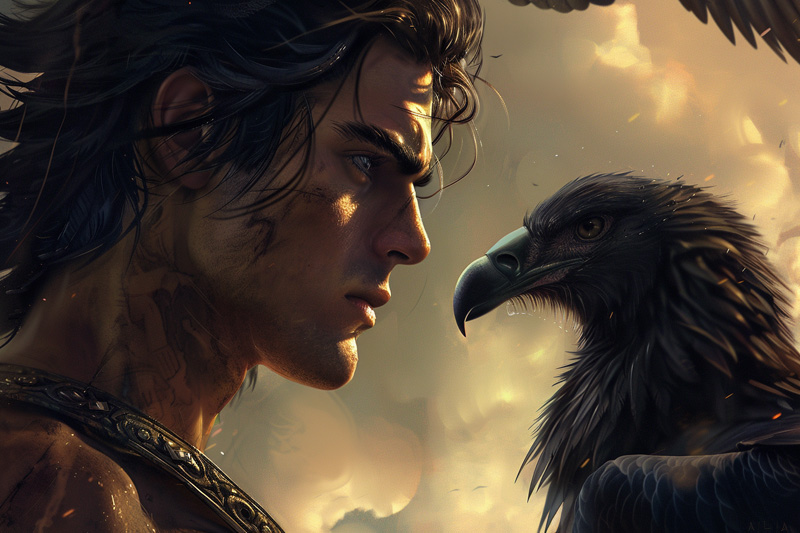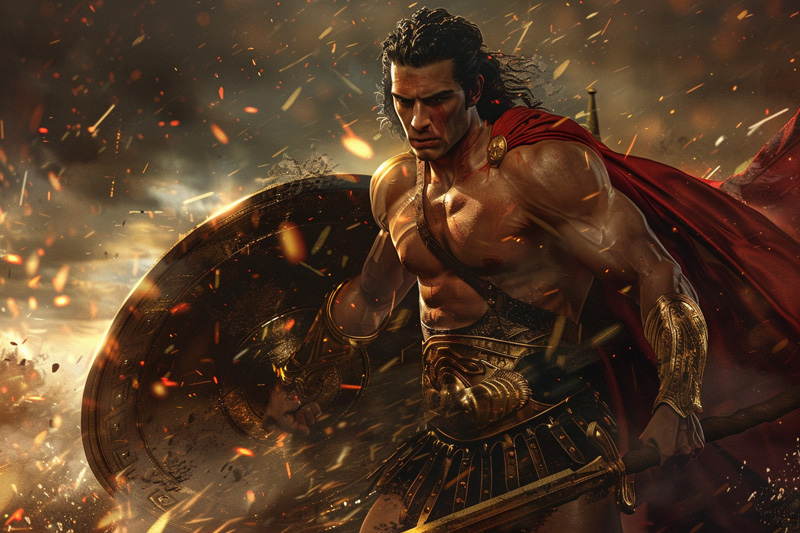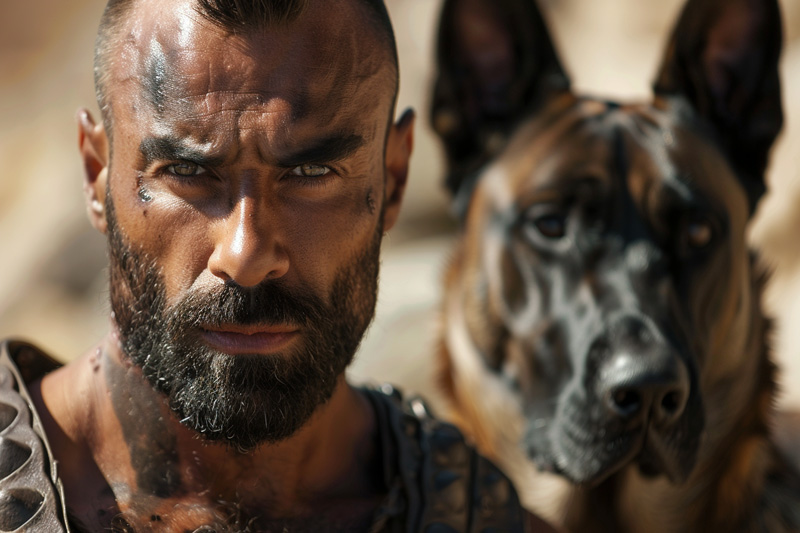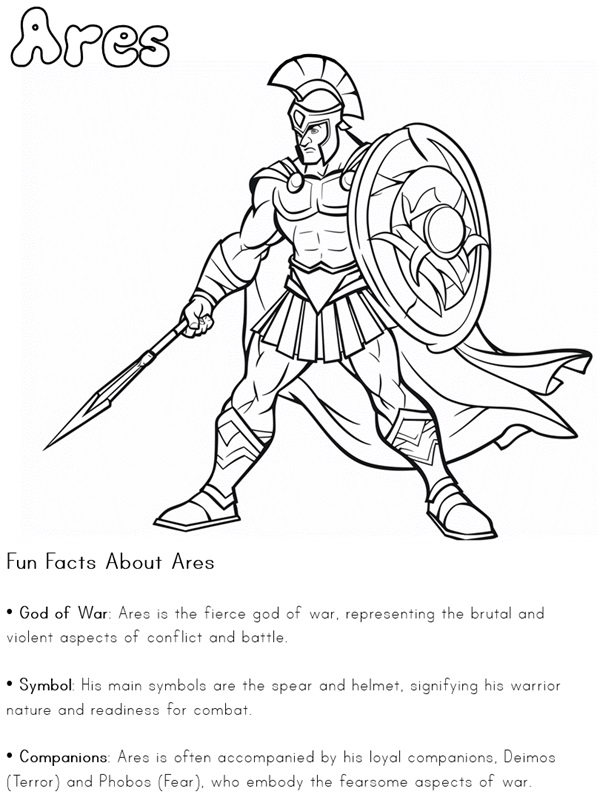KidZone Geography: Greek Mythology
About Ares, God of War
Introduction to Ares
Ares, one of the twelve Olympian deities in Greek mythology, is the god of war. Known for his fierce and aggressive nature, Ares represents the brutal and chaotic aspects of warfare. Often depicted in full armor and wielding weapons, Ares is a complex and controversial figure, embodying the destructive force of battle and the valor of warriors.

Quick Facts About Ares
What is Ares the Greek god of?
Ares is the Greek god of war. He embodies the physical, violent, and untamed aspects of conflict, in contrast to Athena, who represents strategic and tactical warfare.
What are Ares's sacred animals?
Ares's sacred animals include the vulture and the dog. The vulture symbolizes death and scavenging, while the dog represents loyalty and ferocity in battle.

What are Ares's symbols?
Ares's primary symbols are the spear and the helmet. These items represent his role as a warrior and his involvement in battle. The chariot and the shield are also associated with him, highlighting his martial prowess.
Origins and Birth
The Titanomachy
Ares is the son of Zeus and Hera, born to them after their marriage. Unlike other gods who participated in the Titanomachy, Ares's role in the war against the Titans is not well-documented, reflecting his more solitary and aggressive nature, separate from the collaborative efforts of his siblings.
Ares's Role in Olympus
Ares's presence on Olympus is marked by his contentious relationships with other gods, especially Athena. While both are deities of war, their approaches are vastly different—Ares relishes the chaos and bloodshed of battle, whereas Athena values strategy and skill. This contrast often leads to conflicts and rivalries between them.
Ares's Role in Greek Mythology

God of War
Ares's primary role is as the god of war, representing the sheer violence and turmoil of battle. He is often called upon in times of conflict to inspire warriors and incite bloodlust. His influence is seen in the chaotic and destructive nature of war, making him a feared and respected figure.
Patron of Warriors
Ares is also the patron of warriors, symbolizing their courage and ferocity. He is invoked by soldiers seeking strength and protection in battle, and his favor is considered essential for victory. Despite his aggressive nature, Ares embodies the honor and bravery of warriors.
Iconography and Symbols

The Spear and Helmet
The spear and helmet are Ares's most recognizable symbols, representing his role as a warrior. These items are often depicted in art and literature, highlighting his martial prowess and readiness for battle.
The Chariot
The chariot is another significant symbol of Ares, symbolizing his swiftness and power in battle. It is often depicted being drawn by fire-breathing horses, emphasizing his formidable presence on the battlefield.
The Shield
The shield represents Ares's protective aspect, guarding warriors in the heat of battle. It symbolizes his role in ensuring the safety and success of those who fight under his influence.
Major Myths Involving Ares
The Affair with Aphrodite
One of the most famous myths involving Ares is his affair with Aphrodite, the goddess of love. Despite her marriage to Hephaestus, Aphrodite and Ares engaged in a passionate and illicit relationship. This affair was discovered by Hephaestus, who trapped the lovers in a fine net and exposed them to the ridicule of the other gods. This myth highlights Ares's impulsive and passionate nature.
The Capture by the Aloadae Giants
Another notable myth is the capture of Ares by the Aloadae giants, Otus and Ephialtes. These giants imprisoned Ares in a bronze jar for over a year, demonstrating that even the god of war could be overpowered. He was eventually rescued by Hermes, illustrating the vulnerability and fallibility of the gods.
The Battle of Troy
Ares played a significant role in the Trojan War, fighting on the side of the Trojans. His involvement in the conflict was marked by his characteristic ferocity and bloodlust. However, he was wounded by Diomedes with the help of Athena, highlighting the perpetual conflict between the two war deities.
Ares's Relationships and Offspring
Affairs and Lovers
Ares had numerous lovers, both mortal and divine, resulting in many offspring. His most famous affair was with Aphrodite, with whom he fathered several children, including Eros (Cupid), the god of love; Phobos (Fear); Deimos (Terror); and Harmonia (Harmony).
Divine and Mortal Offspring
Ares's children played significant roles in various myths and legends. Some of his notable offspring include:
- Eros (Cupid): The god of love, often depicted with a bow and arrows, symbolizing the power of love to wound hearts.
- Phobos and Deimos: Personifications of fear and terror, who often accompanied their father into battle, spreading panic among his enemies.
- Harmonia: The goddess of harmony and concord, representing the balance that often follows conflict.
Worship and Cult of Ares

Temples and Sanctuaries
Ares was worshipped throughout ancient Greece, though his cult was less widespread compared to other gods. Significant temples dedicated to him include:
- The Temple of Ares in Athens: Located in the Agora, this temple was a center for his worship and a symbol of his influence in the city.
- The Sanctuary of Ares at Sparta: Reflecting the militaristic culture of Sparta, this sanctuary honored Ares as a vital deity in their society.
Festivals and Rituals
Several festivals celebrated Ares's martial nature and honored his contributions to war and conflict. The most notable of these is the Areopagus, a hill in Athens where trials for homicide and other serious crimes were held, reflecting his association with justice and retribution.
Ares in Art and Literature

Classical Depictions
In classical art, Ares is often depicted as a handsome, muscular warrior in full armor, carrying a spear and shield. These representations emphasize his physical prowess and readiness for battle, highlighting his role as the god of war.
Renaissance and Beyond
During the Renaissance, artists like Rubens and Botticelli drew inspiration from classical depictions of Ares, incorporating him into their works. Rubens' paintings often portrayed Ares in dramatic and dynamic scenes, reflecting his powerful and aggressive nature.
Modern Interpretations
In modern times, Ares continues to be a prominent figure in literature, film, and popular culture. He appears in various forms, from comic books and movies to television series and video games. These contemporary portrayals often explore different aspects of his character, from his brutal aggression to his complex relationships. In the Percy Jackson series, for example, Ares is depicted as a fierce and intimidating god, reflecting modern interpretations of his myth.
Conclusion
Ares remains one of the most dynamic figures in Greek mythology. His role as the god of war, combined with his complex personality and significant myths, make him a fascinating character. As the embodiment of the chaotic and destructive aspects of battle, Ares's influence extends across the divine and mortal realms. His enduring influence can be seen in the continued fascination with his myths and the artistic representations that keep his legend alive. Through his worship, iconography, and the rich tapestry of stories that surround him, Ares exemplifies the intensity and complexity of ancient Greek religion and mythology.

